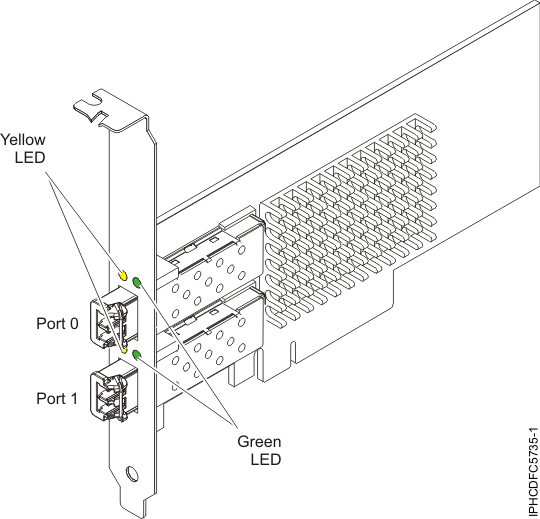8 Gb PCI Express Dual-port Fibre Channel Adapter (FC 5735; CCIN 577D)
Learn about the specifications and operating system requirements for the feature code (FC) 5735 adapter.
Overview
The 8 Gb PCI Express Dual-port Fibre Channel Adapter is a high-performance adapter based on the Emulex LPe12002 PCIe Host Bus Adapter (HBA). Each port provides single initiator capability over a fibre link. The ports have LC type connectors and utilize shortwave laser optics. The adapter connects to fibre channel switches and operates at link speeds of 2, 4, and 8 Gbps. The adapter automatically negotiates with the switch to the highest speed of which the switch is capable. LEDs on each port provide information on the status and link speed of the port.

Adapter specifications
- Item
- Description
- FRU number
- 10N9824 (Designed to comply with RoHS requirement)
- Wrap plug FRU number
- 12R9314Note: The wrap plug is included with the card, and can also be purchased from IBM®.
- I/O bus architecture
- PCI Express (PCIe)
Base and Card Electromechanical (CEM) 2.0
x8 PCIe bus interface - Slot requirement
- For details about slot priorities and placement rules, see PCIe adapter placement rules and slot priorities and select the system you are working on.
- Voltage
- 3.3 V
- Form factor
- Short, low-profile with standard size bracket
- FC compatibility
- 2, 4, 8 Gigabit
- Cables
- Cables are the responsibility of the customer. Use multimode
fibre optic cables with short-wave lasers that adhere to the following
specifications:
- OM3: Multimode 50/125 micron fibre, 2000 MHz x km bandwidth
- OM2: Multimode 50/125 micron fibre, 500 MHz x km bandwidth
- OM1: Multimode 62.5/125 micron fibre, 200 MHz x km bandwidth
- The following table shows the supported distances for the three
different cable types at the three different link speeds.
Table 1. Supported cable distances by link speed Cable type 2.125 Gbps 4.25 Gbps 8.5 Gbps OM3 0.5 m - 500 m 0.5 m - 380 m 0.5 m - 150 m OM2 0.5 m - 300 m 0.5 m -150 m 0.5 m - 50 m OM1 0.5 m - 150 m 0.5 m - 70 m 0.5 m - 21 m - Maximum number
- For details about the maximum number of adapters that are supported, see PCIe adapter placement rules and slot priorities and select the system you are working on.
Adapter LED
Green and yellow LEDs can be seen through openings in the adapter mounting bracket. Green indicates firmware operation and yellow signifies port activity. Table 2 summarizes the link rate conditions. There is a 1-second pause when the LED is off between each group of fast flashes (2, 3, or 4). Observe the LED sequence for several seconds to be sure that you have correctly identified the state.
| Green LED | Yellow LED | State |
|---|---|---|
| Slow flash | Off | Normal, link inactive or not started |
| On | 2 fast flashes | 2 Gbps link rate - normal, link active |
| On | 3 fast flashes | 4 Gbps link rate - normal, link active |
| On | 4 fast flashes | 8 Gbps link rate - normal, link active |
Power-on self test (POST) conditions and results are summarized in Table 3. These states can be used to identify abnormal states or problems. Follow the action to be taken for each condition.
| Green LED | Yellow LED | State | Action to be taken |
|---|---|---|---|
| Off | Off | Wake-up failure (dead board) | Perform AIX®, Linuxor IBM i operating system diagnostics. |
| Off | On | POST failure (dead board) | Perform AIX, Linuxor IBM i operating system diagnostics. |
| Off | Slow blink | Wake-up failure monitor | Perform AIX, Linuxor IBM i operating system diagnostics. |
| Off | Fast blink | POST failure | Perform AIX, Linuxor IBM i operating system diagnostics. |
| Off | Flashing | POST processing in progress | None |
| On | Off | Failure while functioning | Perform AIX, Linuxor IBM i operating system diagnostics. |
| On | On | Failure while functioning | Perform AIX, Linuxor IBM i operating system diagnostics. |
| Slow blink | Slow blink | Offline for download | None |
| Slow blink | Fast blink | Restricted offline mode, waiting for restart | None |
| Slow blink | Flashing | Restricted offline mode, test active | None |
Replacing Fibre Channel adapters using hot swap
When hot swapping fibre channel adapters, be aware that device-related software for the storage devices might have additional devices (for example, the dar device associated with the FAStT or DS4800) that need to be removed. Refer to specific storage device documentation for information about how to remove these additional devices.
The new adapter has a unique worldwide port name (WWPN). Check the zoning and LUN assignments to ensure that the new adapter will function as expected.
Operating system or partition requirements
If you are installing a new feature, ensure that you have the software that is required to support the new feature and that you determine whether any prerequisites must be met for this feature and attaching devices. To check for the prerequisites, see IBM Prerequisite website.
- AIX
- AIX Version 7.1, or later
- AIX Version 6.1, or later
- AIX Version 5.3, or later
- Linux
- Red Hat Enterprise Linux 6.1 for POWER®, or later
- SUSE Linux Enterprise Server 11, Service Pack 1, or later (with update package)
- Ubuntu 16.04.1 or later
- For support details, see the Linux Alert website.
- IBM i
- IBM i Version 7.2 or later
- IBM i Version 7.1, or later
